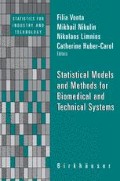Abstract
Starting from the distribution of frailty amongst individuals with lifetimes between t 1 and t 2, we construct a graphical diagnostic for the correct choice of frailty distribution in a proportional hazards model. This is based on a closure property of certain frailty distributions in the case t 2 → ∞ (i.e., among survivors at time t 1), namely that the conditional frailty distribution has the same form as the unconditional, with some parameters remaining the same. We illustrate the plot on the Stanford heart transplant data. We investigate the application of the same principle to the case of shared frailty, where the members of a cluster share a common value of frailty. A similar plot can be used when the cluster lifetime is defined as the shortest lifetime of the cluster’s members. Other definitions of cluster lifetime are less useful for this purpose because the closure property does not apply.
Access this chapter
Tax calculation will be finalised at checkout
Purchases are for personal use only
Preview
Unable to display preview. Download preview PDF.
References
Economou, P. and Caroni, C. (2005). Graphical tests for the assumption of gamma and inverse Gaussian frailty distributions, Lifetime Data Analysis, 11, 565–582.
Hougaard, P. (1984). Life table methods for heterogeneous populations: Distributions describing the heterogeneity, Biometrika, 71, 75–83.
Hougaard, P. (2000). Analysis of Multivariate Survival Data, Springer-Verlag, New York.
Hougaard, P., Harvald, B., and Holm, N. V. (1992). Measuring the similarities between the lifetimes of adult Danish twins born between 1881–1930. Journal of the American Statistical Association, 87, 17–24.
Kalbfleisch, J. D. and Prentice, R. L. (2002). The Statistical Analysis of Failure Time Data (2nd ed.), John Wiley & Sons, New York.
Vaupel, J. A., Manton, K. G., and Stallard, E. (1979). The impact of heterogeneity in individual frailty on the dynamics of mortality, Demography, 16, 439–454.
Author information
Authors and Affiliations
Editor information
Editors and Affiliations
Rights and permissions
Copyright information
© 2008 Birkhäuser Boston
About this chapter
Cite this chapter
Economou, P., Caroni, C. (2008). Closure Properties and Diagnostic Plots for the Frailty Distribution in Proportional Hazards Models. In: Vonta, F., Nikulin, M., Limnios, N., Huber-Carol, C. (eds) Statistical Models and Methods for Biomedical and Technical Systems. Statistics for Industry and Technology. Birkhäuser Boston. https://doi.org/10.1007/978-0-8176-4619-6_4
Download citation
DOI: https://doi.org/10.1007/978-0-8176-4619-6_4
Publisher Name: Birkhäuser Boston
Print ISBN: 978-0-8176-4464-2
Online ISBN: 978-0-8176-4619-6
eBook Packages: Mathematics and StatisticsMathematics and Statistics (R0)

